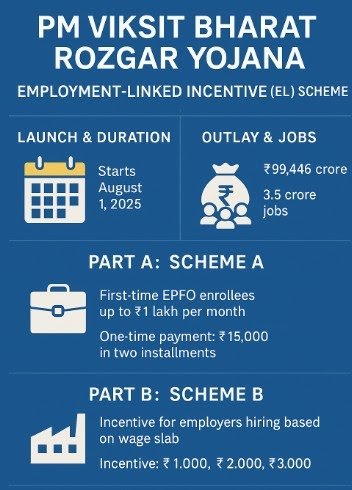[ad_1]
Abstract
The PM Viksit Bharat Rozgar Yojana (PM‑VBRY) marks a transformative leap in India’s labor policy landscape, introduced to formalize employment and expand social security coverage through financial incentives to employers and employees. Operational from August 1, 2025, the scheme aims to generate 3.5 crore jobs within two years. This paper critically evaluates the legal structure, implementation mechanisms, compliance mandates, and expected impact of the scheme, referencing key statutory provisions under the Employees’ Provident Funds and Miscellaneous Provisions Act, 1952, and aligning the policy within the broader framework of labor reforms and economic recovery.
1. Introduction
India’s employment ecosystem has witnessed a structural shift with the introduction of the PM‑VBRY, a wage-linked incentive scheme aiming to boost formal sector jobs and address post-pandemic unemployment challenges. The Cabinet approval on July 1, 2025, and its implementation via EPFO from August 2025, places this initiative as a core pillar of the government’s vision for a “Viksit Bharat”.
2. Legal Framework and Statutory Basis
The scheme operates within the framework of the Employees’ Provident Funds and Miscellaneous Provisions Act, 1952, read with:
-
The EPF Scheme, 1952 (Para 36 & 38 on contributions and ECR filing)
-
Aadhaar (Targeted Delivery of Financial and Other Subsidies, Benefits and Services) Act, 2016 (for DBT linkage)
-
Labour Codes (esp. Code on Social Security, 2020 – yet to be fully enforced)
3. Scheme Structure and Eligibility
3.1 Scheme A – First-Time Formal Workers
-
Applicable to employees joining the EPFO for the first time after August 1, 2025
-
Wage eligibility: Gross monthly wage ≤ ₹1,00,000
-
Incentive: ₹15,000 paid in two installments:
-
After 6 months of continuous employment
-
After 12 months, subject to financial literacy completion
-
-
Delivery: DBT via ABPS, with part locked in savings
3.2 Scheme B – Employer Incentive for Net New Hires
-
Applicable to establishments registering net increase in workforce over a defined base year (Aug 2024–Jul 2025)
-
Incentive per new employee:
-
₹1,000 (wages up to ₹10,000)
-
₹2,000 (₹10,001 to ₹20,000)
-
₹3,000 (₹20,001 to ₹1,00,000)
-
-
Tenure:
4. Administrative Directives & Compliance
The EPFO issued a compliance circular dated 22.07.2025, mandating:
-
Accurate monthly reporting of gross wages in ECR
-
Applicability from wage month August 2025
-
Enforcement through zone and district EPFO offices
“It is hereby reiterated that all employers must ensure correct entry relating to gross wages in the ECR to be filed from wage month August 2025 onwards.”
— EPFO Circular No. ELI/GrossWagesinECR/2025/E-1132964
5. Comparative Evaluation with Predecessors
The PM‑VBRY structurally builds on the Atmanirbhar Bharat Rozgar Yojana (ABRY) (2020–2022), with the following distinctions:
| Feature | ABRY | PM‑VBRY |
|---|---|---|
| Wage Limit | ₹15,000 | ₹1,00,000 |
| Focus | PF Contribution Reimbursement | Wage-based Cash Incentives |
| Employer Incentive Tenure | 2 years | Up to 4 years (manufacturing) |
| Employee Eligibility | New EPFO joiners | First-time formal sector + wage cap |
6. Policy Impact and Projections
According to the government announcement:
-
3.5 crore jobs targeted
-
₹99,446 crore outlay
-
Emphasis on first-time formal employment (1.92 crore workers)
-
Stimulates demand for skilled labor and formal contracts
-
Encourages financial inclusion through financial literacy and savings-linked DBT
7. Challenges and Concerns
-
Compliance Burden: MSMEs may lack digital payroll systems for accurate gross wage filing
-
Monitoring Fraudulent Claims: Baseline distortion and ghost employees risk must be addressed
-
Overlap with Labour Codes: Implementation delays of new codes may affect legal clarity
-
Financial Literacy Course Framework: Lacks detailed operational mechanism as of July 2025
8. Conclusion and Recommendations
The PM‑VBRY offers a strategic push toward formalization and employment generation. For effective implementation:
-
Awareness campaigns among MSMEs and HR professionals must be intensified
-
EPFO should integrate auto-validation tools in ECR filing systems
-
Launch of a central dashboard for public monitoring of scheme uptake
-
Ensure integration with Code on Social Security, 2020, upon its notification
Appendices
-
Annexure 1: EPFO Circular dated 22.07.2025
-
Annexure 2: Cabinet Press Release – July 2025
-
Annexure 3: ECR Format – Gross Wage Field Requirement
Bibliography (Bluebook Format)
-
Employees’ Provident Funds and Miscellaneous Provisions Act, No. 19 of 1952, § 6 (India).
-
Press Information Bureau, Cabinet Approves Employment Linked Incentive Scheme (July 1, 2025), https://pib.gov.in.
-
Employees’ Provident Fund Organisation, Circular No. ELI/GrossWagesinECR/2025/E-1132964 (July 22, 2025).
-
EY India, Understanding India’s New Employment Incentive Scheme (July 2025), https://www.ey.com.
-
The New Indian Express, PM Viksit Bharat Rozgar Yojana to Begin August 1 (July 24, 2025), https://newindianexpress.com.
-
The Economic Times, How You Can Earn ₹15,000 Under New EPFO Scheme (July 2025), https://economictimes.indiatimes.com.
-
The Code on Social Security, 2020, No. 36 of 2020, Ministry of Labour and Employment.
[ad_2]
Source link

